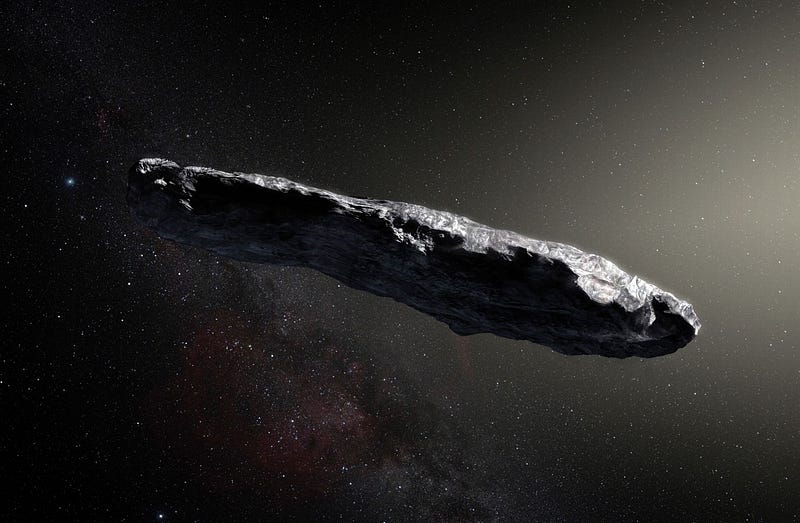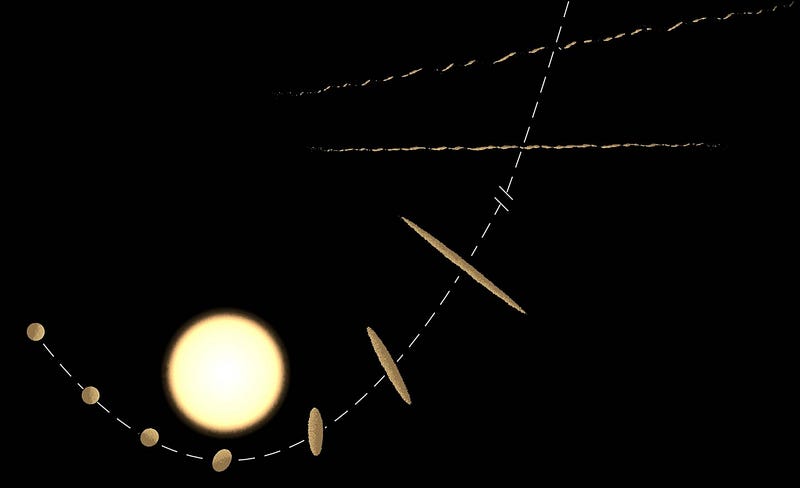Unveiling the Mysteries of Oumuamua: An Interstellar Enigma
Written on
Chapter 1: The Discovery of Oumuamua
The first known interstellar object, ‘Oumuamua, captured attention upon its discovery in October 2017. Its peculiar shape and trajectory sparked numerous inquiries, prompting researchers to delve into its origins and characteristics.

A few months back, I discussed the second interstellar object, a comet designated C/2019 Q4 (Borisov). This comet was identified by a Ukrainian amateur astronomer who spotted it racing through the night sky on August 30 of last year. This significant finding was particularly remarkable as C/2019 Q4 (Borisov) was observed on its approach to our Solar System.
In contrast, ‘Oumuamua was recorded while exiting our Solar System, leading to a flurry of research focused on its unique attributes. Its elongated, cigar-like form measuring approximately 400 meters (1,300 feet) long and its rapid velocity of 59,000 mph (95,000 km/h) as it swung past the sun raised more questions than answers. This interstellar traveler exhibited comet-like behavior, releasing gases during its acceleration, which is not typical for asteroids.
Researchers even entertained the idea that it could be an alien probe due to its dry surface and bizarre motion. However, a year-long study by the Search for Extraterrestrial Intelligence (SETI) dismissed this theory.
“It is really a mysterious object, but some signs, like its colors and the absence of radio emission, point to ‘Oumuamua being a natural object.”
~ Lead Author, Yun Zhang
Section 1.1: Understanding Oumuamua's Characteristics
After conducting extensive research on ‘Oumuamua, scientists from the Chinese Academy of Sciences and the University of California, Santa Cruz, utilized computer modeling to elucidate its shape, trajectory, and outgassing features.

Their simulations suggested that ‘Oumuamua might be a remnant of a larger planetary body, shaped by a process known as "tidal disruption." This phenomenon likely occurred as the object approached a star, causing its surface to melt and later re-solidify into a crust that maintained its unique form as it was catapulted into the void of space.
This theory accounts for its comet-like qualities as well. Although ‘Oumuamua lacks a traditional comet tail, it may harbor volatile substances beneath its surface that began to vaporize once it neared the Sun.
Section 1.2: Alternative Theories
Numerous theories attempt to explain the origins of ‘Oumuamua. Some propose that it was propelled into interstellar space due to the gravitational influence of a binary star system or a nearby star nudging it off its course. However, none of these hypotheses have provided the depth of analysis achieved in the current study.
Chapter 2: Future Interstellar Discoveries
The ongoing exploration of interstellar objects like ‘Oumuamua may yield further insights into their origins and properties.
This video titled "Interstellar object 'Oumuamua" dives deeper into the fascinating characteristics of the first interstellar object discovered, discussing its shape, trajectory, and the ongoing research surrounding it.
The second video, "First Interstellar Asteroid Wows Scientists," highlights the excitement and scientific implications of discovering such unique celestial bodies, including Oumuamua and its fellow traveler Borisov.